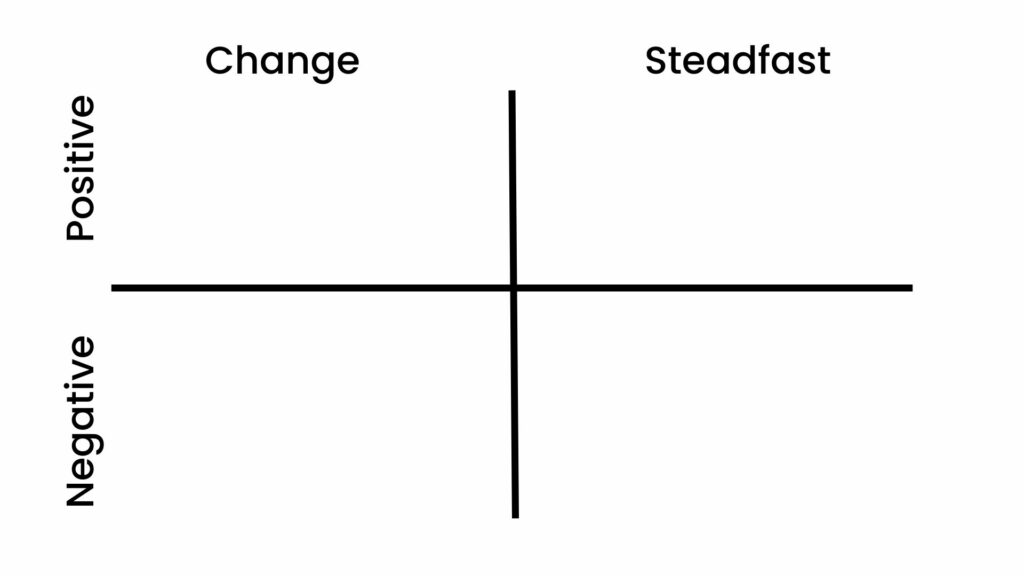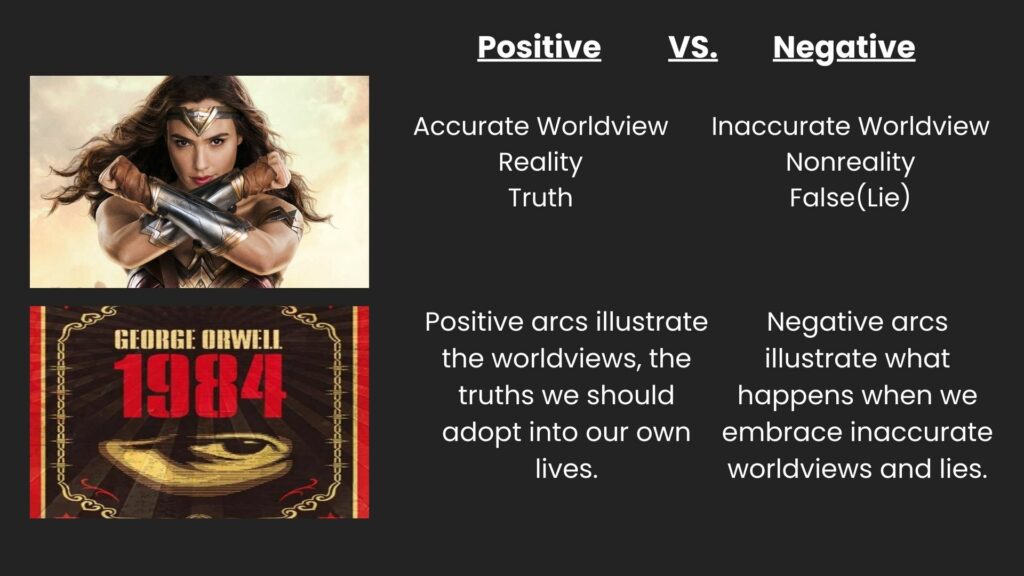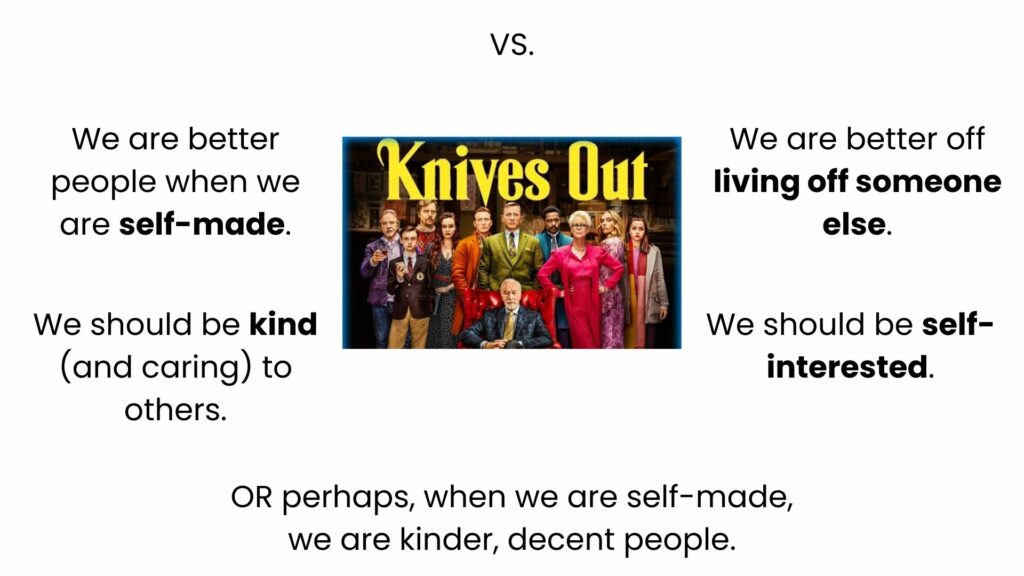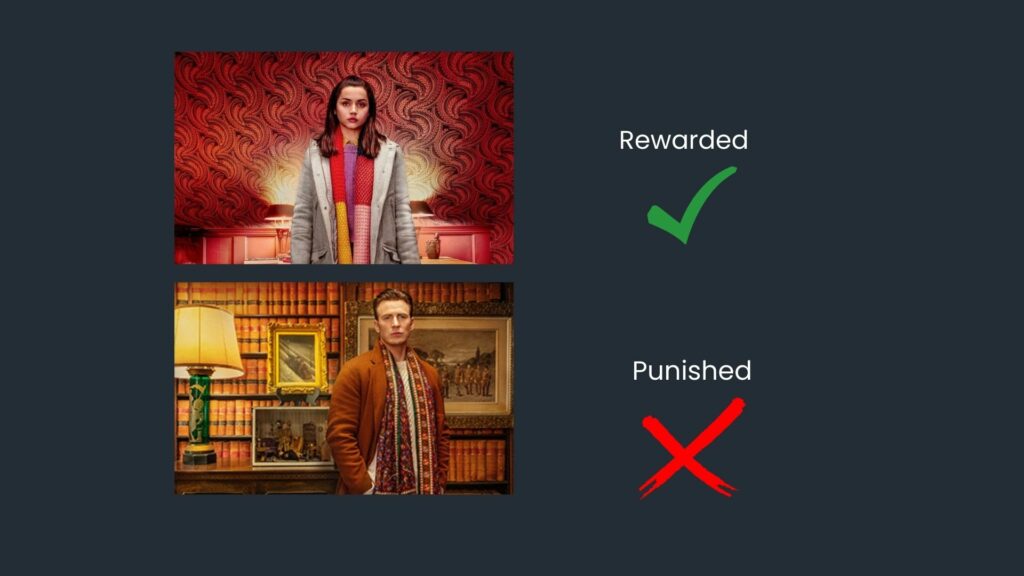Negative characters arcs are about more than a character being “bad.” Learn what’s at the heart of negative arcs, and answer some questions to help you write one for your character.
The 4 Basic Character Arcs
A “character arc” is how a character grows in a story. While this term gets used broadly in the writing community to refer to any kind of change a character goes through, a true character arc is an internal journey.
And simplistically speaking, there are only two ways a character can grow internally:
- The character changes who he is.
- The character strengthens his resolve in who he is, by remaining steadfast.
And there are two types of each:
- Positive (becoming someone better)
- Negative (becoming someone worse)
This means at the most basic level, there are just four types of character arcs: positive change, negative change, positive steadfast, and negative steadfast.

By far the most common choice for protagonists is positive change.
But it’s not the only option.
And also, other characters besides the protagonist may arc. Not all of them need to have a positive change arc like the protagonist. In fact, it’s likely another character will have a notable character arc that isn’t positive change.
Unfortunately though, if you are writing anything other than a positive change arc, there aren’t a lot of resources to help you with that. . . .
Luckily I’ll be talking about these three other options in more depth in Apex. On July 1st, I’ll go over these basic arcs in more detail and then get into negative arcs. And on August 5th, I’ll cover positive steadfast arcs.
For now, here is a little more on negative arcs, as a sneak peek . . .
At the Heart of Negative Character Arcs
Negative character arcs happen when a character grows into a worse person. While somewhat uncommon for protagonists, nearly every author will write a negative-arcing character at some point, whether that’s the antagonist or a supporting character, so it’s useful to know how negative arcs actually work.
A common myth is that negative arcs are only for “bad guys.” While it’s true most villains will have a negative arc, not all characters with negative arcs are villains. In 1984, for example, Winston has a negative arc, but none of us would call him a villain. He was tortured until he betrayed Julia and embraced doublethink.
Negative arcs aren’t necessarily about being evil, wicked, or bad. They are about being in the wrong. They are about embracing or living a lie.
And most of all, they are about being lost and misled.
That is at the heart of negative arcs.
In comparison, positive character arcs happen when a character grows into a better person, specifically by demonstrating what is considered to be right. These characters represent the correct way to live, at the end of the story. They illustrate what is “true” within the context of that story. This doesn’t mean that they’re perfect, just that they hold an accurate worldview.
When labeling arcs as “positive” or “negative,” we often look at the character’s morals, standards, and lifestyle. However, the best way to categorize characters as such, is to evaluate them according to the story’s theme.

A Thematic Argument
The theme is the argument the story is making about life. For example, Les Miserables argues that mercy is more powerful than justice, through the experiences of Jean Valjean and other characters. Knives Out argues that when we are self-made, we are kinder people, which is shown through Marta and Harlan’s family as Detective Blanc works to solve the case.
But a theme is meant to be an argument, and it’s not really an argument if no one is disagreeing. So, the story should also have a counterargument in play. In Les Miserables, the counterargument is that justice is more powerful than mercy, as demonstrated by Javert’s loyalty to the law. And in Knives Out the counterargument is that we are better off living off others and being self-interested, as best demonstrated by Ransom, who hasn’t earned a dime in his life.
While there is usually one main counterargument (which I call the anti-theme), there may be other counterarguments or misbeliefs that oppose the story’s theme. (There may also be more than one theme in a story.)
Living the Truth or the Lie
Ultimately, though, positive arcing characters illustrate the theme as being “true” or “correct” at the end of the story. They demonstrate the right way to live. Jean Valjean finally wins his conflict with Javert, by extending mercy. Marta receives Harlan’s inheritance and goes free because she was kind and self-made.
And, ultimately, negative-arcing characters illustrate the counterargument, or at least a flawed or inaccurate worldview related to the theme, at the climax of the story. They demonstrate the wrong way to live life. Javert is so committed to justice as the highest power, that when Valjean does not kill him, he cannot live with it and kills himself. Ransom tries to frame Marta, so that he can continue to live off Harlan’s wealth. Each negative character meets a dismal end.


Neither character learns what they should have, and embraced the theme.
Negative-arcing characters ultimately reject the “true” worldview, and instead embrace a false worldview, a “lie.”
In 1984, Winston ultimately lets go of reality, and is brainwashed.
Anakin rejects the idea that he should accept loss, and instead, “sacrifices” everything around him to resist it.
Negative arcs are about believing what is wrong, and as such have the capacity to be a uniquely empathetic and tragic experience.
But of course, if you want your negative-arcing character to be as terrible of a jerk as Ransom, you can do that too.
As a writer, you get to decide how sympathetic the audience can feel about your character.
Regardless, as the writer, you should still understand where that character is coming from. Why does this person think what’s wrong, is right?
Here are some questions and exercises to help you develop a negative arc.
Questions & Exercises for Negative Arcs
Why does your character believe in, or come to believe in, this incorrect worldview?
Is this a deliberate choice on his or her part (an act of stubbornness)? Or does it come from ignorance? How so?
Is there anything in the past (such as a ghost) that relates to the character’s worldview?
What are the best arguments you would make on behalf of this worldview (the anti-theme)? What are its half-truths? In what situations does it seem like it could be true or correct?
Often at the climax of the story, the character will choose between the correct worldview (the theme) and the incorrect worldview (the anti-theme), and the negative-arcing character will pick the incorrect worldview. How might this show up in your story?
Write from the POV of the character, and have the character explain why he or she believes this is the right way forward to get what he or she most wants.
Negative-arcing characters often put their wants before what is needed. What does your character want deeply? What is he or she willing to do to get it?
Generally speaking, negative arcs are about bringing destruction (whether that is intentional or not). Rather than building up themselves or their societies, negative-arcing characters are tearing them down. How is this character bringing about destruction?
How can you show the negative consequences of the character choosing to embrace the wrong belief?
Curious to learn more? Join us for our Mastermind Apex Call on July 1st.
About September C. Fawkes:

Sometimes September C. Fawkes scares people with her enthusiasm for writing. She works as a freelance editor, writing instructor, and writing tip blogger. She has edited for both award-winning and best-selling authors as well as beginning writers. September is best known for her blog (SeptemberCFawkes.com) which won the Writer’s Digest 101 Best Websites for Writers Award and Query Letter’s Top Writing Blog Award. When not editing and instructing, she’s penning her own stories. Some may say she needs to get a social life. It’d be easier if her fictional one wasn’t so interesting.




